by Christian Huelsman
MISSION
About ten years ago, I began to take greater notice of public corridors that were overgrown, poorly lighted, and trashed. I had to wonder who was charged with the upkeep of alleys and public stairways. When it was clearly evident that they had not been on the city service docket for decades, I knew someone had to make a real difference.
Spring in Our Steps was created with a mission is to bring a brighter future to Cincinnati’s most neglected public corridors – such as public alleys and stairways–through cleanup, programming, advocacy, and preservation. Our board consists of planners, architects and neighborhood activists who seek to elevate these public corridors for safer walking and neighborhood integration. Hundreds of volunteers have made it possible to produce nearly 200 events over eight years, in order to preserve alleys and stairways in Cincinnati as vital public, cultural assets.
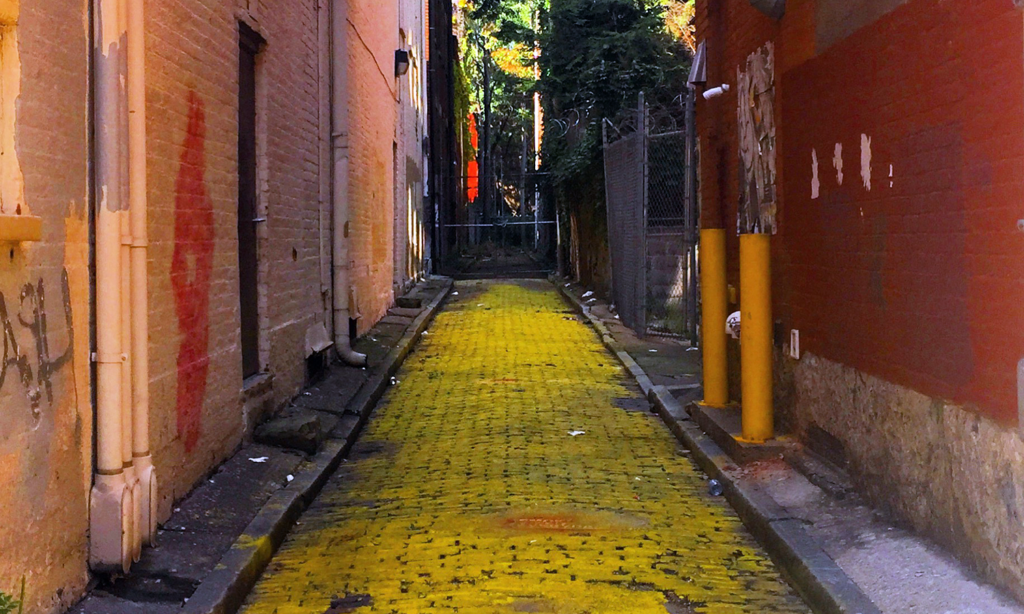
CLEANUP
We began our work in Mount Auburn, where St. Joe Street and South Wendell Alley had languished for decades. Other early sites in Mount Auburn, Over-the-Rhine and Clifton Heights saw clearance of thick layers of litter, dumping, and organic debris. What drove interest was the common desire to uncover historic pavement and bring those surfaces back to the present-day. The tireless work of numerous volunteers and partners made it possible to reverse decades of neglect in these walking avenues. Our work later expanded to alleys and stairways in 25 neighborhoods throughout the city, for a total of 160 cleanup events.
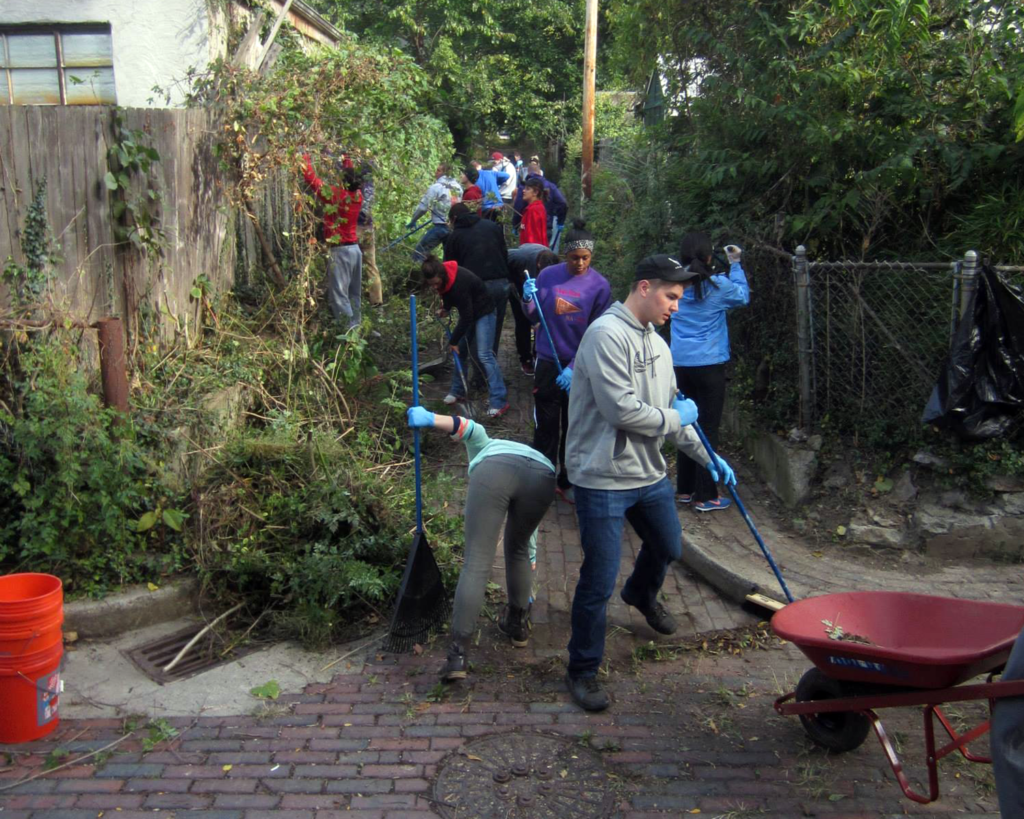
The US Bank/Haile Foundation stepped in with funding to grow our capacity, tapping the Cincinnati Development Fund as a fiscal agent. Spring in Our Steps became a 501(c)3 organization in June 2015. US Bank/Haile Foundation funded our growth in 2016, which allowed us to pursue more ambitious projects. This support really enabled us to transition from a band of colleagues to a resilient organization with reliable storage, tool rental and event supplies.
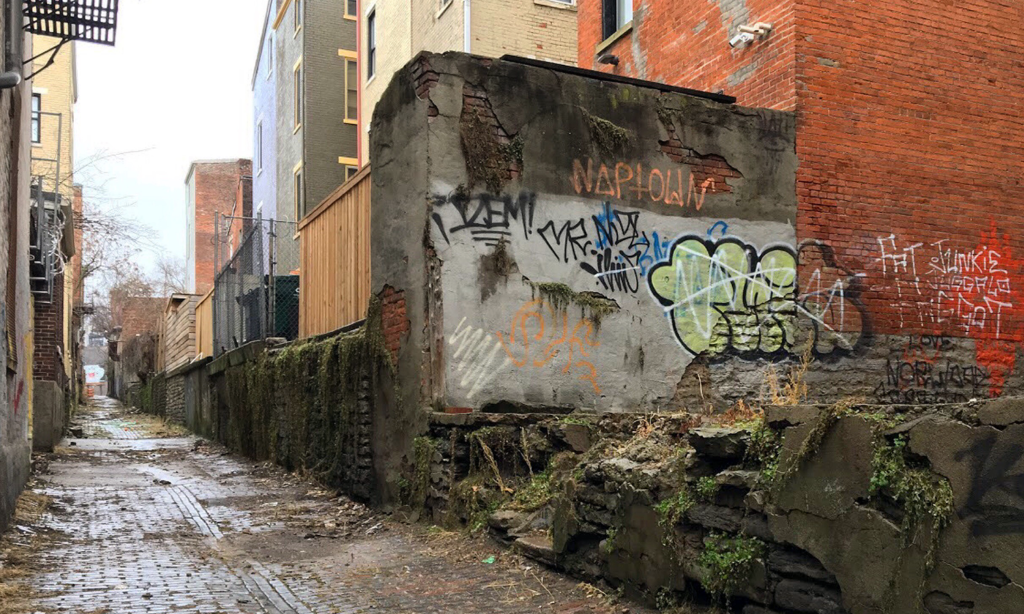
In 2018, we collaborated with the Pendleton neighborhood and ArtWorks to improve a long alley corridor: Bolivar and Levering Alleys. The alley had long been a narrow, recessed corridor filled with trash, furniture, and weeds. Over several cleanup events, our teams improved conditions by removing litter, sediment, invasive growth, tires, logs, and demolition debris. None of that progress would have been possible without the availability of Cincinnati Community ToolBank as a resource, neighborhood funding, and subsequent aid from the City of Cincinnati Safe and Clean Fund Grant. Those activities paved the way for street artists and ArtWorks-trained apprentices to fill it with murals. In response to our historical research, the ArtWorks New Lines II: Bolivar Alley mural project was dedicated on August 31, 2018, 130 years to the day that the alley was renamed from its former name of Anna Alley. The neighborhood continues to support lasting improvements to the corridor, such as installing pedestrian-scaled solar lighting and planters to restrict alleys from illegal auto parking.
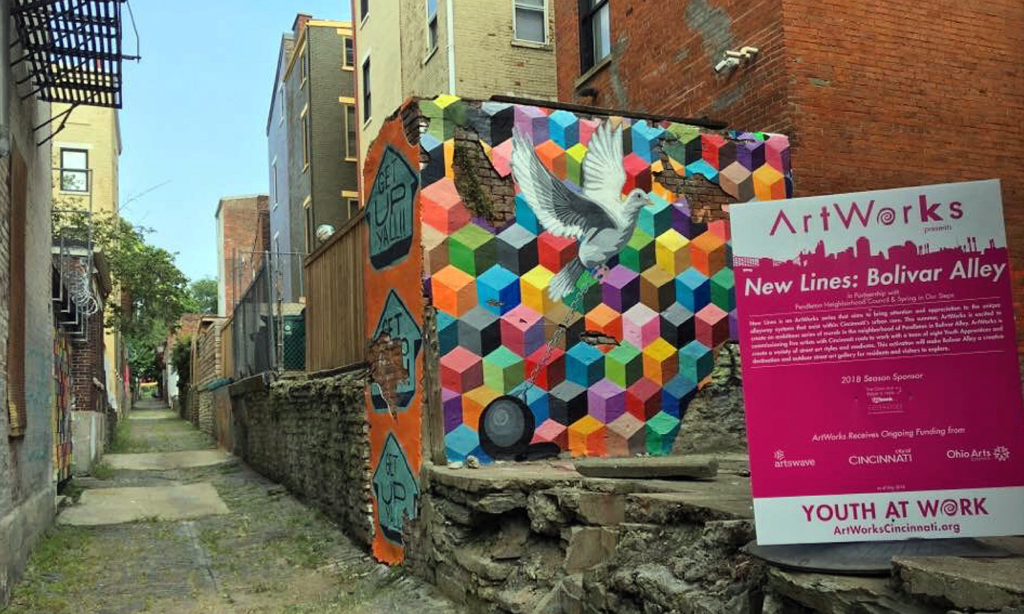
Since late 2019, Spring in Our Steps has partnered with residents in South Fairmount to restore access to several public stairways. A large number of stairs in the neighborhood can be found with “Steps Closed” signs or overgrown beyond the degree of safe passage. Jacquie Chischillie reached out to me in early 2019, looking to partner with us to clean and beautify the stairs. Concurrently, the Metropolitan Sewer District has been working on a massive stormwater infrastructure project, The Lick Run Greenway, flanked by the transit-heavy Queen City and Westwood Avenues. (Resulting from a 2006 consent decree from the U.S. Environmental Projection Agency (EPA), Metropolitan Sewer District (MSD) was charged to resolve issues with combined sewer overflows. A proposed solution to sewer management from the EPA was to essentially daylight the Lick Run in South Fairmount, channeled through a conduit back in the 1890s to facilitate development. MSD has been working on the Lick Run Greenway, as part of the Lower Mill Creek Partial Remedy, for several years.)
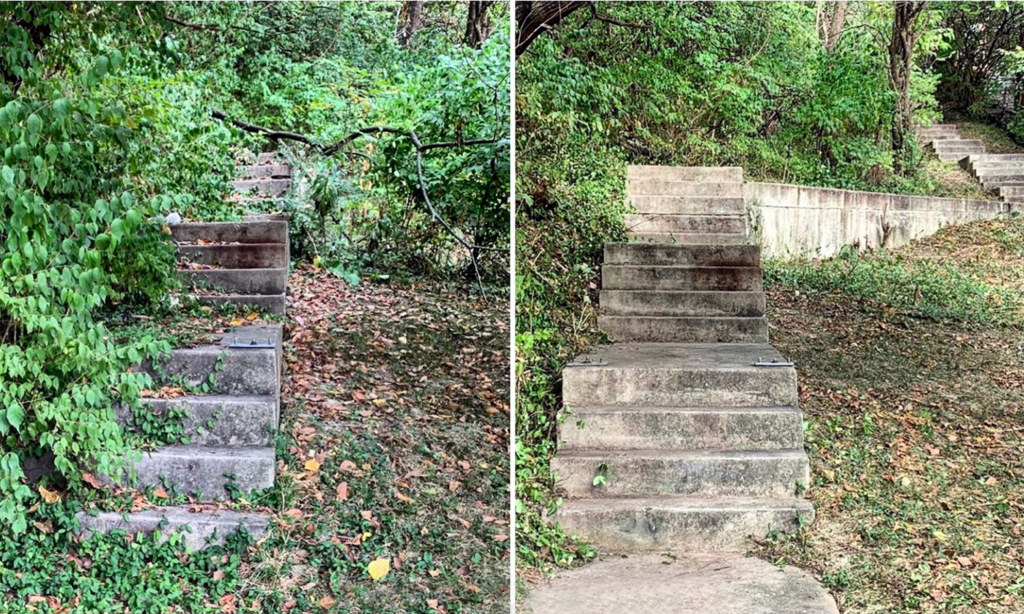
The project will be completed in 2021 yet, while it may become a community asset and regional attraction, many public stairways leading to transit corridors continue to be closed by the Department of Transportation and Engineering. We find it unacceptable that walking access in South Fairmount continues to be eroded, at the same time that an invasive sewer project essentially plants an asset right in the heart of the neighborhood.
We continue to work with community residents to improve conditions at those public stairways, building momentum from past cleanup events at the Adler Street Steps, Rankin Street Steps, and the monumental Fairmount Avenue Steps en route to Saint Clair Heights Park. Fortunately, stalwarts in South Fairmount find it imperative to reinstate neighborhood public stairways as vital community connections, particularly in a place long dominated by automobiles. Future cleanup events include impacts to the Van Hart Street Steps and Kebler Alley Steps, connecting Westwood Avenue to the hillside neighborhood streets.

PROGRAMMING
In addition to cleanups, Spring in Our Steps has hosted dozens of events over the years, in efforts to elevate conditions of the alleys and stairways for safer (and more desirable) walking and biking. Those activation projects have included walking tours, film screenings, art exhibitions, musical performances, lawn bowling, and miniature golf, each using alleys as a venue. We’ve participated in Cincy Summer Streets, hosting lawn bowling, mini-golf, and temporary paint-by-number of brick surfaces. Through it all, we ensured that these activation events welcomed people of all ages, with the goal of making everyone comfortable in a traditionally stigmatized urban space.
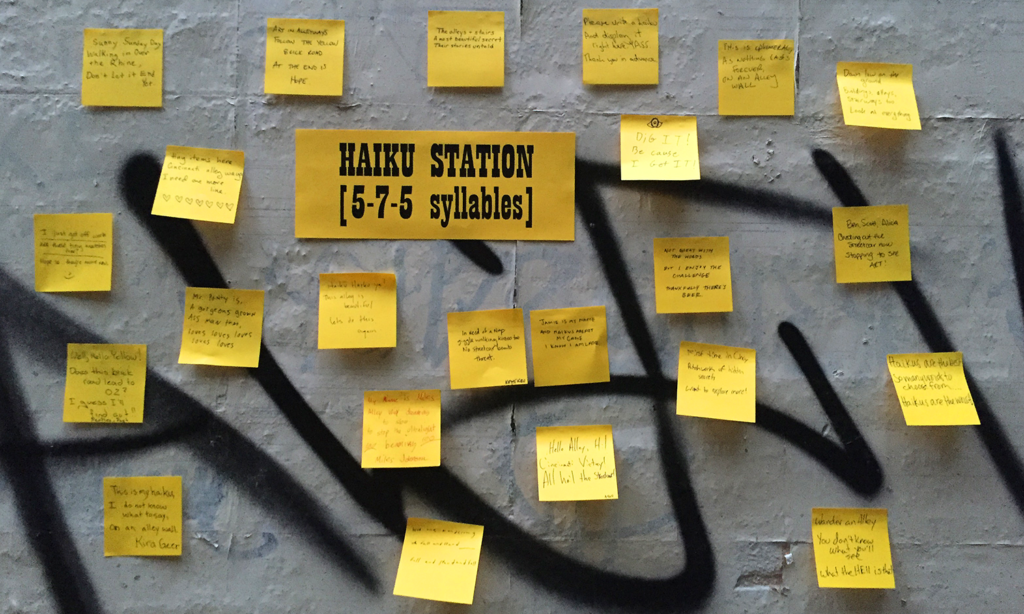
The programming hub for Spring in Our Steps has been the intersection of Coral and Drum Alleys in Over-the-Rhine. Since our cleanup work in 2014, we have tested the site potential for film, performance, games, and mixed media art. A collaboration with Ledge Gallery in 2017, during Second Sunday on Main, brought Kleingassefest, “a celebration of all things tiny,” featuring installations and photography from nearly a dozen artists.
Film-based events like Dead End Film Fest, Stiefelkatzenjammer, and Block Fest provided passersby during Final Friday the opportunity to view short films from local producers and around the world, sing karaoke, dance to vinyl records, and view the alley space in a whole new light. In 2019, we took our lighting installations, karaoke, and short film exhibition to Rodney and Hart Alleys for BLINK.
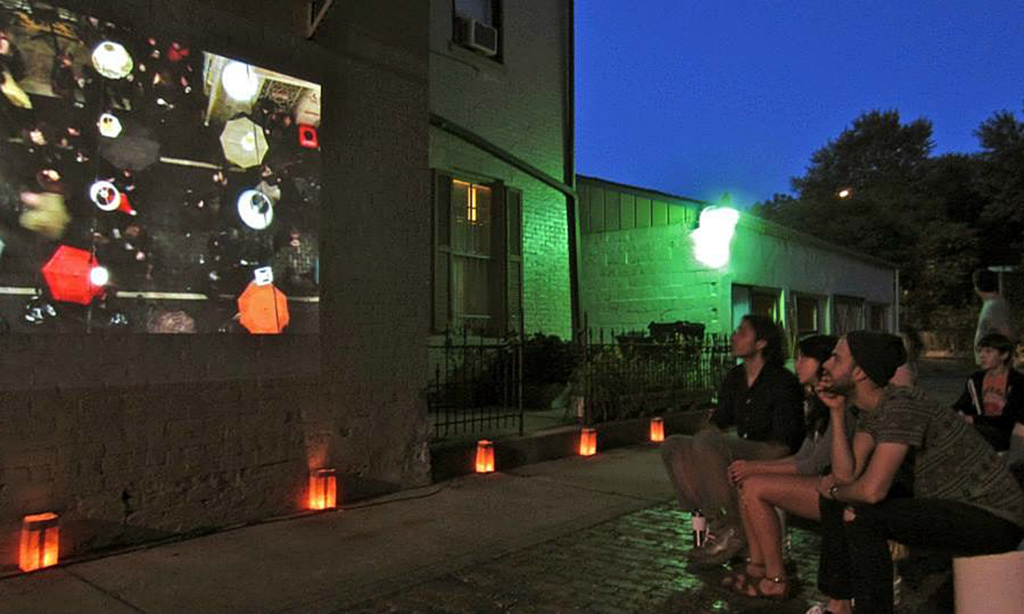
Walking and biking tours have also helped to bring new eyes and feet to alleys and stairways throughout Cincinnati. I even developed a route for the second edition of the Walking Cincinnati book by Dan Korman, through the Clifton Heights-Fairview neighborhood. The route includes stairways and alleys in the community, as well as some of my favorite historic buildings and small businesses. Fortunately, that route will endure long after any particular group outing. Here’s hoping we manage one or two tour events in 2020, in the face of the pandemic.
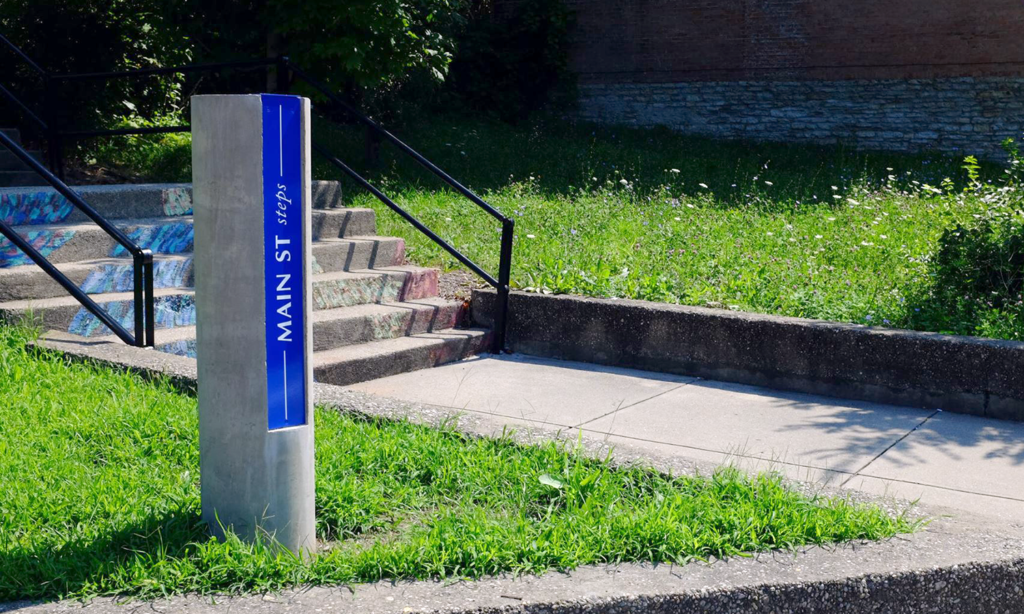
ADVOCACY
The foundation of Spring in Our Steps’ advocacy efforts was built on early engagement during public input sessions for PLAN CIncinnati, the city’s comprehensive plan, which was adopted in 2012. That plan includes action steps ranging from maintenance of the public alley and stairway systems to maintaining alleys as part of the pedestrian network. That was just the beginning. We are committed to putting pressure on the city to follow through on a long-term goal in the plan: “to develop, fund, and implement a right-of-way preservation plan that identifies rights-of-way for all modes of transportation to ensure adequate and appropriate connectivity in a safe, accessible, and efficient manner.” It is critical to have proper signage to identify public spaces, in order to expect people to identify with them and take ownership of them.
We submit service requests and show persistence in the addition of street signage. We have on-going dialogue and partnerships with abutting property owners and city staff, highlighting where critical stairway or alley connections are at-risk of becoming less safe, impassable, barricaded, or sold. I do not believe that, without that dialogue, we would have seen lighting enhancements from Duke Energy, increased maintenance of invasive growth in alleys by Public Services, or removal of illegal barricades in public alleys and stairs.
Truly, one of the proudest moments in our organizational history was the fruition of a four-year collaboration with the Department of Transportation and Engineering. Back in late 2013, while we continued to clear South Wendell Alley, we noticed children figured out how to squeeze through the barricade at the top of the steps. Then they walked down the newly cleared alley to Mulberry Street, en route to Rothenberg Preparatory Academy. Through dialogue with city staff, they realized there were some unused neighborhood funds. I worked with them on the Stairway & Alley Signage Project, identifying locations along the gateway between Over-the-Rhine and Mount Auburn where signage would give identity to these intimate walking corridors. The Neighborhood Enhancement Program luckily coincided with the project, which enabled Spring in Our Steps to push for enhanced street lighting as well.

Spring in Our Steps successfully fought against the sale of Kemp Alley in Over-the-Rhine to Chatfield College in 2013. The school wanted to envelop a pocket park and the alley for northern expansion of its campus. Instead, its preservation enabled future residential infill and rehabilitation of historic structures on the block bound by Kemp Alley, Fall Alley, Wade Street, and Central Parkway. We also fought for the preservation and restoration of Curry and Porter Alleys in the West End, which were at risk of erasure by expansion plans of St. Vincent de Paul. After several years, and a couple rejections by the City, the alleys were taken over by the organization for use as private parking. The alleys were fortunately restored, however, for future consideration of development at a neighborhood scale.
Most recently, we have heard concerns about the risk of privatization of St. Joe Street, an alley in Mount Auburn off Rice Street. I was alarmed, especially considering that this is where Spring in Our Steps began its work. We reached out to the City’s Transportation and Engineering Department to express dismay over the illegal paving of the alley with asphalt, which created drainage issues, damaged limestone curbs and blocked stormwater inlets. Since then, removal of the asphalt has been ordered, and the city plans to elevate the entryway to the alley, addressing longtime drainage issues. As a board, we plan to keep our attention on this area, as well as other connections to Vine Street Hill, exploring ways that the public stairway can be open to people on foot for the first time in over 25 years. This work is at the core of what we came to represent and defend – restoring access to public alleys and stairways for people on foot and enhancing that experience.
Christian Huselman is the founder and Executive Director of Spring in Our Steps. Follow the organization on Facebook and Instagram to learn about upcoming events and volunteer opportunities.
